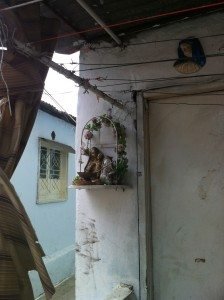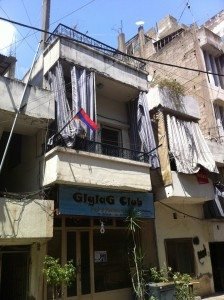My working method as a novelist has become clearer to me with each new book. Like a bird building a nest, I collect scraps and fragments of stories from people who have lived through a particular historical moment. A memory is encoded into narrative, and the narrative is anchored in a specific place and time. The historical moments that fire my imagination are, for better or worse, times of collective upheaval and violence—the Armenian Genocide, World War II, and now the Beirut Civil War. I’m also always interested in the marginal detail, the outsider’s voice, and the version of the story that calls into question the prevailing narrative. While I love writing, I love the research even more. And the part of the research that is completely engaging is hearing from people their individual accounts, and then placing those personal and idiosyncratic stories within a broader historical context. Right now I’m taken with the character and the characters of Bourj Hammoud.

When I was in Paris researching my third novel, which is set in the Armenian community of Belleville during the Nazi occupation, my friend Hagop served as my fixer. He arranged meetings for me with surviving Armenian members of the French Resistance, and other compatriots who had lived through the war years in Paris. But Hagop also introduced me to his circle of friends, all of them Armenians from Beirut, most of them from Bourj Hammoud, who had immigrated to France during the Lebanese Civil War.
My interest in the Armenians in France during World War II was spurred by my fascination with the post-Genocide Armenian Diaspora experience. My novel, All the Light There Was, grew out of this question: What was it like for Armenian Genocide survivors to have come to Paris and to have rebuilt their lives and their communities, only to look out the window and see German troops marching down the Rue de Belleville?
The novel I’m working on now, about Armenians of Bourj Hammoud who immigrated to the United States during the Lebanese Civil War, was inspired by the conversations I heard between Hagop and his friends while I was in Paris. They were the children and grandchildren of genocide survivors who had reconstructed their lives and their communities in Beirut. Armenians, who benefited from the Lebanese attitude that allowed for “integration without assimilation,” thrived in Beirut for several decades. The Armenian community in the late 1960’s and early 1970’s in Beirut, and in Bourj Hammoud in particular, experienced an intellectual and artistic flowering—a plethora of literary magazines, newspapers, publishing houses, theaters, plays, folk music, and the like. Hagop and his friends were writing, directing, and acting in plays; composing and singing songs; and studying painting, sculpture, and architecture. And then in 1975, the Civil War erupted, tearing the fabric of the Armenian community yet again. (I must say here as an aside, recent photos from the Armenian precincts of Aleppo are devastating in the way they reproduce images from the Lebanese Civil War.)

So I see Bourj Hammoud as one of a long series of places that are not just simply locations, but also markers of dispossession and exile. For Armenians since the genocide, it’s a difficult task to preserve a place, or at the least to hold onto some of the public buildings, homes, and other landmarks that make a neighborhood or even a city. But it turns out that what preserves those spaces the most, at least for this seemingly permanently wandering community, are the stories that people tell. So I think of my novels as kinds of preservation projects, allowing us to return to those places while acknowledging their evanescent quality. Perhaps by telling stories from their past, we can gain the power and consensus to help preserve their present.
In the case of Beirut, when I started asking people about their memories of the Civil War, fully expecting that the narratives would date to 1975, I was startled by the number of people who wanted to tell me what happened among and between the Armenians of Beirut in 1958, as though understanding that earlier conflict was necessary to understanding the later one, and the position of “positive neutrality” that the Armenians adopted vis-à-vis the various warring Lebanese political factions in 1976.
In 1958, the different Armenian political parties had aligned themselves with either the pro-Western, Lebanese nationalist groupings or with the proponents of pro-Nasser pan-Arabism. This led to a struggle over the naming of a new patriarch in Antelias, and to brutal internecine killings among the Armenians that outlasted by a few months the violence between the Lebanese parties. Even people who were too young to have witnessed the events of 1958 told stories that had been recounted to them by their parents—of family members and friends who had been killed during that fratricidal few months, of women who defiantly defended a church surrounded by militiamen and troops, of a grandfather who was framed and imprisoned for a murder that someone else had committed.
Then there were the anecdotes from the early days of the Civil War in the mid-1970’s. The war erupted in 1975, and the scars from 1958 pushed the Armenians to adopt “positive neutrality,” but not before there had been several assassinations. I also heard from a number of residents of Bourj Hammoud belonging to different political parties that after 1976 the community came together to form patrols to protect the Armenian enclave from looting and other violence by outsiders. One man recalled watching from the highway the massacre at Karantina in 1976, and how the scenes he witnessed that day haunt him still.
Sometimes it seems as though my work is to walk among ghosts—the ghosts of old villages, the faded photographs of lost churches, and the long-ago stories of our dead handed down from generation to generation. In July 2012, I went to Beirut for the first time to do preliminary research for my novel. I spent five afternoons in Bourj Hammoud visiting shops, apartment buildings, schools, and churches, and traveling the streets where my characters would walk. The Civil War was long past, but it seemed everyone I met had a story to tell from that time.
One afternoon, my guide led me across the highway overpass to what was left of Sanjak Camp, the last Armenian refugee camp in Lebanon. Half the neighborhood had already been demolished and there were trash heaps in empty lots, but there were also small scenes of nostalgic beauty— the potted plants on the balconies of the houses that remained, the family altars still hanging from the facades of several homes. I was not only a witness to the lives of Sanjak Camp’s present inhabitants—people without running water, many without electricity—who were being pressured to leave so that a new shopping mall could go up, but I could also imagine, amidst the narrow streets and crumbling staircases, what the place had looked like soon after it was built in the 1930’s by Armenian refugees.
Shouldn’t someone save what was left of Sanjak and restore the old wooden houses, making the place a living memorial to those resilient, hard-working survivors? My guide shrugged. Too much money, no interest, and too late. But maybe what we can do is to tell the stories, and in our stories these people and these buildings will survive.


As always, your writing is beautifully descriptive and very informative. Thank you.
I can’t wait to read the next novel!
Very interesting. I hope to read the novel.
Very nice report